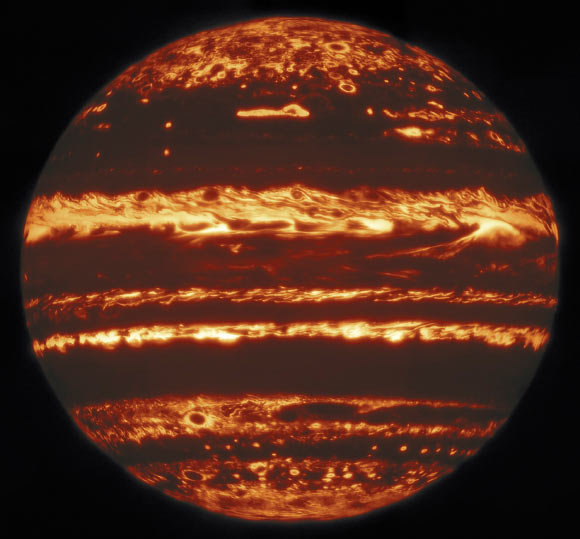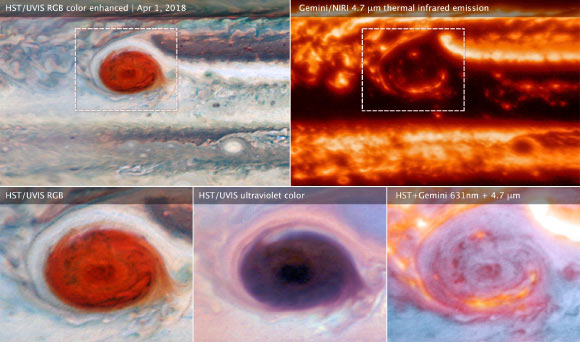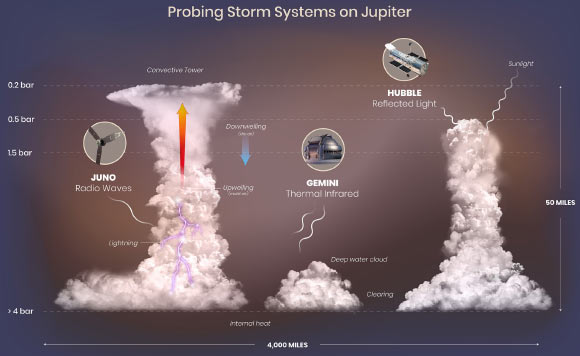Juno, Hubble, Gemini Observatory Probe Jovian Storm Systems | Astronomy – Sci-News.com
Multiwavelength observations from the NASA/ESA Hubble Space Telescope and Gemini Observatory combined with close-up views from NASA’s Juno spacecraft reveal that lightning strikes and huge storm systems that create them in Jupiter’s atmosphere are formed in and around large convective cells over deep clouds of water ice and liquid; the observations also confirm that dark spots in the famous Great Red Spot are actually gaps in the cloud cover and not due to cloud color variations.

This illustration of lightning, convective towers (thunderheads), deep water clouds, and clearings in Jupiter’s atmosphere is based on data collected by the Juno spacecraft, the Hubble Space Telescope, and the Gemini Observatory. Juno detects radio signals generated by lightning discharges. Because radio waves can pass through all of Jupiter’s cloud layers, Juno is able to detect lightning in deep clouds as well as lightning on the day side of the planet. Hubble detects sunlight that has reflected off clouds in Jupiter’s atmosphere. Different wavelengths penetrate to different depths in the clouds, giving researchers the ability to determine the relative heights of cloud tops. Gemini maps the thickness of cool clouds that block thermal infrared light from warmer atmospheric layers below the clouds. Thick clouds appear dark in the infrared maps, while clearings appear bright. The combination of observations can be used to map the cloud structure in three dimensions and infer details of atmospheric circulation. Thick, towering clouds form where moist air rises (upwelling and active convection). Clearings form where drier air sinks (downwelling). The clouds shown rise five times higher than similar convective towers in Earth’s relatively shallow atmosphere. The region illustrated covers a horizontal span one third greater than that of the continental United States. Image credit: NASA / ESA / M.H. Wong, University of California, Berkeley / A. James & M.W. Carruthers, STScI.
Jupiter’s constant storms are gigantic compared to those on Earth, with thunderheads reaching 64 km (40 miles) from base to top and powerful lightning flashes up to three times more energetic than Earth’s largest ‘superbolts.’
Every 53 days, Juno races low over Jupiter’s storm systems detecting radio signals from lightning bolts known as sferics (short for atmospherics) and whistlers (so-called because of the whistle-like tone they cause on radio receivers), which can then be used to map lightning even on the day side of the planet or from deep clouds where flashes are not otherwise visible.
Coinciding with each pass, Hubble and Gemini watch from afar, capturing high-resolution global views of the planet that are key to interpreting Juno’s close-up observations.
“Juno’s microwave radiometer probes deep into the planet’s atmosphere by detecting high-frequency radio waves that can penetrate through the thick cloud layers,” said Dr. Amy Simon, a researcher at NASA’s Goddard Space Flight Center.
“The data from Hubble and Gemini can tell us how thick the clouds are and how deep we are seeing into the clouds.”

These images of Jupiter’s Great Red Spot were made using data collected by Hubble and Gemini Observatory on April 1, 2018. By combining observations captured at almost the same time from the two different observatories, astronomers were able to determine that dark features on the Great Red Spot are holes in the clouds rather than masses of dark material. Upper left (wide view) and lower left (detail): the Hubble image of sunlight (visible wavelengths) reflecting off clouds in Jupiter’s atmosphere shows dark features within the Great Red Spot. Upper right: a thermal infrared image of the same area from Gemini shows heat energy emitted as infrared light. Cool overlying clouds appear as dark regions, but clearings in the clouds allow bright infrared emission to escape from warmer layers below. Lower middle: an ultraviolet image from Hubble shows sunlight scattered back from the haze over the Great Red Spot. The Great Red Spot appears red in visible light because the haze absorbs blue wavelengths. The Hubble data show that the haze continues to absorb even at shorter ultraviolet wavelengths. Lower right: a multiwavelength composite of Hubble and Gemini data shows visible light in blue and thermal infrared in red. The combined observations show that areas that are bright in infrared are clearings or places where there is less cloud cover blocking heat from the interior. The Hubble and Gemini observations were made to provide a wide-view context for Juno’s 12th pass. Image credit: NASA / ESA / M.H. Wong, University of California, Berkeley.
By mapping lightning flashes detected by Juno onto optical images captured of the planet by Hubble and thermal infrared images captured at the same time by Gemini, Dr. Simon and colleagues were able to show that lightning outbreaks are associated with a three-way combination of cloud structures:
(i) deep clouds made of water;
(ii) large convective towers caused by upwelling of moist air — essentially Jovian thunderheads;
(iii) and clear regions presumably caused by downwelling of drier air outside the convective towers.
The data from Hubble’s Wide Field Camera 3 (WFC3) show the height of the thick clouds in the convective towers, as well as the depth of deep water clouds.
The data from Gemini’s Near-Infrared Imager (NIRI) clearly reveal the clearings in the high-level clouds where it is possible to get a glimpse down to the deep water clouds.
“We think that lightning is common in a type of turbulent area known as folded filamentary regions, which suggests that moist convection is occurring in them,” said Dr. Michael Wong, a researcher at the University of California, Berkeley.
“These cyclonic vortices could be internal energy smokestacks, helping release internal energy through convection. It doesn’t happen everywhere, but something about these cyclones seems to facilitate convection.”

This graphic shows observations and interpretations of cloud structures and atmospheric circulation on Jupiter from Juno, Hubble and the Gemini Observatory. By combining the Juno, Hubble and Gemini data, researchers are able to see that lightning flashes are clustered in turbulent regions where there are deep water clouds and where moist air is rising to form tall convective towers similar to cumulonimbus clouds (thunderheads) on Earth. The bottom illustration of lightning, convective towers, deep water clouds and clearings in Jupiter’s atmosphere is based on data from Juno, Hubble and Gemini, and corresponds to the transect (angled white line) indicated on the Hubble and Gemini map details. The combination of observations can be used to map the cloud structure in three dimensions and infer details of atmospheric circulation. Thick, towering clouds form where moist air is rising (upwelling and active convection). Clearings form where drier air sinks (downwelling). The clouds shown rise five times higher than similar convective towers in the relatively shallow atmosphere of Earth. The region illustrated covers a horizontal span one-third greater than that of the continental United States. Image credit: NASA / ESA / M.H. Wong, University of California, Berkeley / A. James & M.W. Carruthers, STScI / S. Brown, JPL.
With Hubble and Gemini observing Jupiter more frequently during the Juno mission, the astronomers were also able to study short-term changes and short-lived features like those in the Great Red Spot.
Images from Juno as well as previous missions to Jupiter revealed dark features within the Great Red Spot that appear, disappear and change shape over time.
It was not clear from individual images whether these are caused by some mysterious dark-colored material within the high cloud layer, or if they are instead holes in the high clouds — windows into a deeper, darker layer below.
Now, with the ability to compare visible-light images from Hubble with thermal infrared images from Gemini captured within hours of each other, it is possible to answer the question.
Regions that are dark in visible light are very bright in infrared, indicating that they are, in fact, holes in the cloud layer.
In cloud-free regions, heat from Jupiter’s interior that is emitted in the form of infrared light — otherwise blocked by high-level clouds — is free to escape into space and therefore appears bright in Gemini images.
The results were published in the Astrophysical Journal Supplement Series.
_____
Michael H. Wong et al. 2020. High-resolution UV/Optical/IR Imaging of Jupiter in 2016–2019. ApJS 247, 58; doi: 10.3847/1538-4365/ab775f
This article is based on press-releases provided by the National Aeronautics and Space Administration and the Association of Universities for Research in Astronomy.






